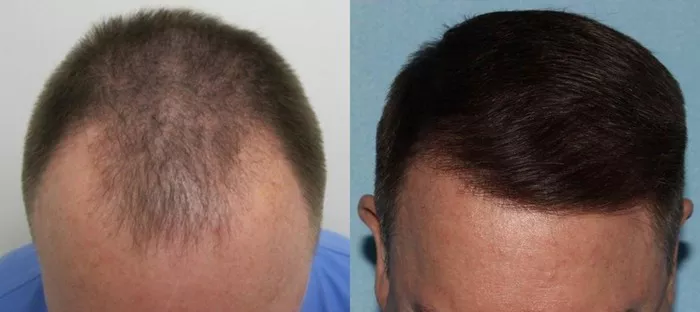Are you considering a hair transplant? If so, you’re likely curious about what happens after the procedure. The post-transplant hair growth process is a critical phase that determines the success of your transplant. In this comprehensive guide, we will delve into the intricacies of post-transplant hair growth, providing you with valuable insights and tips to ensure optimal results.
Understanding the Hair Growth Cycle
Understanding the hair growth cycle is pivotal for anyone considering a hair transplant. This natural process comprises three distinct phases. The anagen phase, characterized by active hair growth, can last several years and significantly impacts hair length. Transitioning into the catagen phase, hair follicles temporarily cease growth, preparing for the telogen phase, a resting period before hair naturally sheds. Recognizing these stages helps set realistic expectations for post-transplant results, as the transplanted hair will undergo similar growth phases. Familiarity with this cycle empowers individuals to make informed decisions about hair transplantation and appreciate the timeline for achieving desired outcomes.
Post-Transplant Hair Growth Timeline
After a hair transplant, it’s crucial to have realistic expectations regarding the timeline of your hair growth. Here’s what you can generally expect:
a. Initial Growth (2-4 months post-transplant)
In the initial months following your hair transplant, you may notice some stubble. This is a positive sign that the transplanted follicles are beginning to grow new hair. However, it’s essential to remain patient during this phase as the hair is still in its infancy.
b. Intermediate Growth (4-6 months post-transplant)
Around the 4-6 month mark, you’ll likely see more significant progress. Your transplanted hair will start to become thicker and longer. While it may not be as long as you desire at this stage, it’s a positive indication of future growth.
c. Substantial Growth (8-12 months post-transplant)
By the 8-12 month mark, you should experience substantial hair growth. Many patients achieve their desired results during this phase, with transplanted hair blending seamlessly with existing hair. However, the rate of growth can vary from person to person.
d. Final Results (12-18 months post-transplant)
The final results of your hair transplant are typically visible between 12-18 months post-procedure. By this time, your hair should have reached its maximum length and thickness, providing a natural and full appearance.
Factors Influencing Post-Transplant Hair Growth
Several factors can influence the success of your post-transplant hair growth:
a. Patient Age
Younger patients often experience more robust and faster hair growth due to their active hair follicles.
b. Genetics
Your genetic predisposition plays a significant role in determining the quality of hair growth. It can affect the texture, color, and overall thickness of your transplanted hair.
c. Proper Aftercare
Following your surgeon’s aftercare instructions diligently is crucial. Avoiding strenuous activities, protecting your scalp from the sun, and using prescribed medications are essential for optimal growth.
d. Surgeon’s Skill
The skill and experience of your surgeon are critical factors in the success of your hair transplant. Choose a qualified and reputable surgeon to ensure the best results.
e. Health and Diet
Maintaining a healthy lifestyle, including a balanced diet and adequate hydration, can positively impact the growth of your transplanted hair.
Maintenance and Long-Term Care
Once you’ve achieved your desired hair growth post-transplant, it’s vital to maintain and care for your new locks. Here are some tips for long-term care:
a. Regular Trimming
Trimming your hair periodically will help maintain its shape and appearance. Consult with your hairstylist for the best trimming schedule.
b. Gentle Hair Care Products
Use gentle, sulfate-free shampoos and conditioners to protect your hair from damage. Avoid excessive heat styling and harsh chemicals.
c. Protect from UV Rays
Shield your hair from harmful UV rays by wearing a hat or using UV-protective hair products when exposed to the sun.
d. Nutritional Supplements
Consider taking supplements that promote hair health, such as biotin and vitamins, to support continued growth and strength.
Real-Life Success Stories
To reinforce the effectiveness of hair transplants, let’s look at some real-life success stories:
a. John’s Transformation
John, a 40-year-old IT professional, experienced significant hair loss. After undergoing a hair transplant, he regained his confidence and a youthful appearance. John’s story is a testament to the life-changing benefits of hair transplants.
b. Sarah’s Journey
Sarah, a 28-year-old marketing executive, struggled with thinning hair for years. Following her hair transplant, she not only saw remarkable growth but also improved self-esteem and a boost in her career.
See Also: [Reveal!] How Long Does Shock Loss Last After Hair Transplant?
Conclusion
In conclusion, understanding the post-transplant hair growth process is essential for anyone considering a hair transplant. It’s a journey that requires patience and commitment, but the results can be life-changing. By grasping the growth timeline, considering influencing factors, and embracing long-term care, you can enjoy a full head of natural-looking hair and a newfound sense of confidence. So, if you’re contemplating a hair transplant, rest assured that a bright, hair-filled future awaits you.


